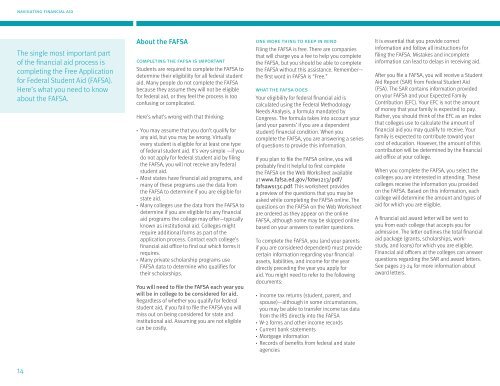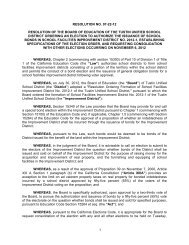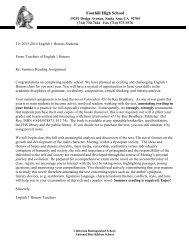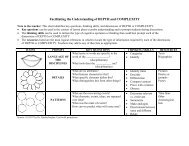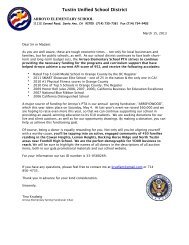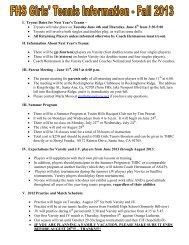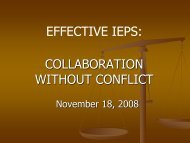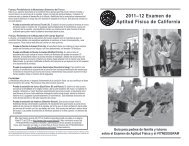College Planning - Tustin Unified School District
College Planning - Tustin Unified School District
College Planning - Tustin Unified School District
You also want an ePaper? Increase the reach of your titles
YUMPU automatically turns print PDFs into web optimized ePapers that Google loves.
navigating financial aid<br />
The single most important part<br />
of the financial aid process is<br />
completing the Free Application<br />
for Federal Student Aid (FAFSA).<br />
Here’s what you need to know<br />
about the FAFSA.<br />
About the FAFSA<br />
completing the fafsa is important<br />
Students are required to complete the FAFSA to<br />
determine their eligibility for all federal student<br />
aid. Many people do not complete the FAFSA<br />
because they assume they will not be eligible<br />
for federal aid, or they feel the process is too<br />
confusing or complicated.<br />
Here’s what’s wrong with that thinking:<br />
··<br />
You may assume that you don’t qualify for<br />
any aid, but you may be wrong. Virtually<br />
every student is eligible for at least one type<br />
of federal student aid. It’s very simple —if you<br />
do not apply for federal student aid by filing<br />
the FAFSA, you will not receive any federal<br />
student aid.<br />
··<br />
Most states have financial aid programs, and<br />
many of these programs use the data from<br />
the FAFSA to determine if you are eligible for<br />
state aid.<br />
··<br />
Many colleges use the data from the FAFSA to<br />
determine if you are eligible for any financial<br />
aid programs the college may offer—typically<br />
known as institutional aid. <strong>College</strong>s might<br />
require additional forms as part of the<br />
application process. Contact each college’s<br />
financial aid office to find out which forms it<br />
requires.<br />
··<br />
Many private scholarship programs use<br />
FAFSA data to determine who qualifies for<br />
their scholarships.<br />
You will need to file the FAFSA each year you<br />
will be in college to be considered for aid.<br />
Regardless of whether you qualify for federal<br />
student aid, if you fail to file the FAFSA you will<br />
miss out on being considered for state and<br />
institutional aid. Assuming you are not eligible<br />
can be costly.<br />
one more thing to keep in mind<br />
Filing the FAFSA is free. There are companies<br />
that will charge you a fee to help you complete<br />
the FAFSA, but you should be able to complete<br />
the FAFSA without this assistance. Remember—<br />
the first word in FAFSA is “Free.”<br />
what the fafsa does<br />
Your eligibility for federal financial aid is<br />
calculated using the Federal Methodology<br />
Needs Analysis, a formula mandated by<br />
Congress. The formula takes into account your<br />
(and your parents’ if you are a dependent<br />
student) financial condition. When you<br />
complete the FAFSA, you are answering a series<br />
of questions to provide this information.<br />
If you plan to file the FAFSA online, you will<br />
probably find it helpful to first complete<br />
the FAFSA on the Web Worksheet available<br />
at www.fafsa.ed.gov/fotw1213/pdf/<br />
fafsaws13c.pdf. This worksheet provides<br />
a preview of the questions that you may be<br />
asked while completing the FAFSA online. The<br />
questions on the FAFSA on the Web Worksheet<br />
are ordered as they appear on the online<br />
FAFSA, although some may be skipped online<br />
based on your answers to earlier questions.<br />
To complete the FAFSA, you (and your parents<br />
if you are considered dependent) must provide<br />
certain information regarding your financial<br />
assets, liabilities, and income for the year<br />
directly preceding the year you apply for<br />
aid. You might need to refer to the following<br />
documents:<br />
··<br />
Income tax returns (student, parent, and<br />
spouse)—although in some circumstances,<br />
you may be able to transfer income tax data<br />
from the IRS directly into the FAFSA<br />
··<br />
W-2 forms and other income records<br />
··<br />
Current bank statements<br />
··<br />
Mortgage information<br />
··<br />
Records of benefits from federal and state<br />
agencies<br />
It is essential that you provide correct<br />
information and follow all instructions for<br />
filing the FAFSA. Mistakes and incomplete<br />
information can lead to delays in receiving aid.<br />
After you file a FAFSA, you will receive a Student<br />
Aid Report (SAR) from Federal Student Aid<br />
(FSA). The SAR contains information provided<br />
on your FAFSA and your Expected Family<br />
Contribution (EFC). Your EFC is not the amount<br />
of money that your family is expected to pay.<br />
Rather, you should think of the EFC as an index<br />
that colleges use to calculate the amount of<br />
financial aid you may qualify to receive. Your<br />
family is expected to contribute toward your<br />
cost of education. However, the amount of this<br />
contribution will be determined by the financial<br />
aid office at your college.<br />
When you complete the FAFSA, you select the<br />
colleges you are interested in attending. These<br />
colleges receive the information you provided<br />
on the FAFSA. Based on this information, each<br />
college will determine the amount and types of<br />
aid for which you are eligible.<br />
A financial aid award letter will be sent to<br />
you from each college that accepts you for<br />
admission. The letter outlines the total financial<br />
aid package (grants, scholarships, workstudy,<br />
and loans) for which you are eligible.<br />
Financial aid officers at the colleges can answer<br />
questions regarding the SAR and award letters.<br />
See pages 23-24 for more information about<br />
award letters.<br />
14


